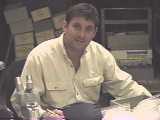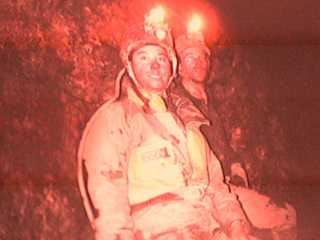![]()

The Wilford Archaeology Laboratory is located in the subbasement of Ford Hall on the University of Minnesota Twin Cities campus and houses a large collection of archaeological materials from all over the world. Artifacts have been donated or excavated over the past 100 years and are available to researchers and educators by appointment. A recently upgraded searchable computer database of the collection is also available for locating particular objects using the computer program Access. The collection houses important historical documents including the notebooks of Theodore H. Lewis, an important early archaeologist and surveyor in Minnesota history and a large slide collection. The facility is used on a daily basis by undergraduate and graduate students in the Department of Interdisciplinary Archaeological Studies (IAS) and the Anthropology Department. The Laboratory is named after Lloyd Wilford (1894-1982) who was one of the pioneers in Midwestern archaeology. Lloyd Wilford held degrees in law, political science, and obtained a Ph.D in Anthropology from Harvard. He wrote the basic manuscript published under Albert Jenks' name on the Brown's Valley and "Minnesota Man" skeletal materials (Minnesota's earliest) and produced the first formal classification of Minnesota's prehistoric sequence. Wilford and Retzek combined to write the first Minnesota Antiquities Law passed in 1939. According to Elden Johnson (1982) "He always claimed that he could pack all of his worldly possessions in two suitcases and was free to live the life of academic year research and teaching, and the vacation time [and] world travel that he so loved." The bibliography attached to Elden Johnson's obituary and compiled by Scott F. Anfinson listed eighty excavation reports and publications which are preserved in the lab named after him. His report on the LaMoille Rock Shelter and his excavations at Nett Lake are examples of particularly significant research which can not now be duplicated.
How to get to Ford Hall(maps, photo, parking, accessibility info.)
The Interdisciplinary Archaeological Program (IAS) website
 Dr. Guy Gibbon, Director
Dr. Guy Gibbon, Director
A very popular pottery workshop, open to the public, was held in the Wilford Archaeology Laboratory facility during Minnesota Archaeology Week in the spring of 1996 and was cosponsored with the Minnesota Society of the Archaeological Institute of America, the Classics Department, and others to describe archaeological methods of excavation, analysis, and preservation of ceramics. Artifacts of the collection are actively used each quarter by the Anthropology Department in teaching courses on Human Origins, Introduction to Archaeology, The Prehistory of Northern Europe, and Method and Theory in Archaeology. The Wilford Archaeological Laboratory also houses the facilities for University of Minnesota field schools in archaeology which in past years has included undergraduate and graduate student reconstruction of pottery excavated in Belize during the summer field season.
The Wilford Archaeological Laboratory has also undertaken several Cultural Resource Management (CRM) projects including a recent excavation at the Gibbs Farm Museum. The Wilford Archaeological Laboratory is available for CRM contract work and has qualified archaeologists available to bid on projects. In association with an active graduate student community outreach program, IAS and Anthropology Department graduate students, frequently use artifacts from the Wilford Laboratory's teaching collection as teaching aids during visits to community schools that range from elementary schools through High School.
 Dan Higginbottom, IAS graduate student
(and a flintknapper) is currently conducting research on Minnesota's
earliest projectile points at the Wilford Archaeology Laboratory.
If you are seeking access to the lab please contact Daniel K. Higginbottom
Department of Interdisciplinary Archaeological Studies
University of Minnesota
higg0003@tc.umn.edu
Dan Higginbottom, IAS graduate student
(and a flintknapper) is currently conducting research on Minnesota's
earliest projectile points at the Wilford Archaeology Laboratory.
If you are seeking access to the lab please contact Daniel K. Higginbottom
Department of Interdisciplinary Archaeological Studies
University of Minnesota
higg0003@tc.umn.edu
Artifacts at the Wilford Archaeological Laboratory include everything from rare Iranian pottery to bronze swords to mammoth teeth from central Europe. Irreplaceable local materials include artifacts that span Minnesota's entire prehistory and history including such items as early Paleo-Indian Clovis projectile points, Old Copper Age knives, Woodland pottery, and Mississippian agricultural implements. Minnesota Historic period artifacts are also also available to researchers and the field notes and artifacts of the many excavations undertaken by the University of Minnesota during the past century are housed here.
A MAMMOTH TOOTH FROM THE CZECH REPUBLIC (photo)
INDEX AND LINKS TO IAS, ANTHROPOLOGY, AND CLASSICS GRADUATE STUDENTS AND FACULTY WEBSITES
SOME OF THE U OF M STUDENTS WHO USE THE WILFORD ARCHAEOLOGY LABORATORY.
 Zak Johnson, IAS Graduate Student is currently surveying
Minnesota caves for unrecorded rock art and is interested in the Wilford Lab's collection
of ceramics and other artifacts from Iran .
Zak Johnson, IAS Graduate Student is currently surveying
Minnesota caves for unrecorded rock art and is interested in the Wilford Lab's collection
of ceramics and other artifacts from Iran .
 Laura McIlrath, IAS Graduate Student is currently doing research on an historical archaeology
project at a 19th century railroad camp in soutwestern Wyoming. Laura organized the Northam Group which meets regularly on Tuesday evenings in Ford Hall to discuss
current research in North American archaeology.
Laura McIlrath, IAS Graduate Student is currently doing research on an historical archaeology
project at a 19th century railroad camp in soutwestern Wyoming. Laura organized the Northam Group which meets regularly on Tuesday evenings in Ford Hall to discuss
current research in North American archaeology.
 Derek Lee, Anthropology Graduate student is currently researching settlement sites
including rock shelters used by early Minnesota settlers in SE Minnesota. Derek recently
upgraded the Wilford Arcaheology Laboratory's database.
Derek Lee, Anthropology Graduate student is currently researching settlement sites
including rock shelters used by early Minnesota settlers in SE Minnesota. Derek recently
upgraded the Wilford Arcaheology Laboratory's database.
 Dan Higginbottom IAS Graduate student has supervised the construction of several experimental iron age furnaces and is currently doing research on Minnesota's early projectile point sequence.
Dan Higginbottom IAS Graduate student has supervised the construction of several experimental iron age furnaces and is currently doing research on Minnesota's early projectile point sequence.
 Debbie Schoenholz a recent IAS graduate and Jackie Hoff with the Anthropology Department are shown here using a Global
Positioning System (GPS) device at an archaeological excavation
in southwestern Minnesota.
Debbie Schoenholz a recent IAS graduate and Jackie Hoff with the Anthropology Department are shown here using a Global
Positioning System (GPS) device at an archaeological excavation
in southwestern Minnesota.

Tom Sanders IAS graduate student is a blacksmith at Historic Fort Snelling and is conducting research on the invention of the American felling axe.

Drew Forsberg IAS Graduate student has been a furnace master on several experimental iron age furnace SMELT projects.
 Jen Tenedine Anthropology Graduate student is currently researching the early Minnesota Fur Trade.
Here she is visiting the Jeffers Petroglyphs site in southwetern Minnesota during the national convention of the Society of American Archaeologists in Minneapolis.
How to get to the Jeffers Petroglyphs & Pipestone National Monument
and The Jeffers Petroglyphs Photo Album
Jen Tenedine Anthropology Graduate student is currently researching the early Minnesota Fur Trade.
Here she is visiting the Jeffers Petroglyphs site in southwetern Minnesota during the national convention of the Society of American Archaeologists in Minneapolis.
How to get to the Jeffers Petroglyphs & Pipestone National Monument
and The Jeffers Petroglyphs Photo Album
 Kevin Callahan, Anthropology Graduate student
demonstrates prehistoric Minnesota atlatls for the public (this is a reproduction). He is a frequent user of
artifacts from the Wilford Archaeology Laboratory's teaching collection in
TAing one of the largest and most popular Anthropology Department courses: Anth. 1101 Human Origins.
Kevin Callahan, Anthropology Graduate student
demonstrates prehistoric Minnesota atlatls for the public (this is a reproduction). He is a frequent user of
artifacts from the Wilford Archaeology Laboratory's teaching collection in
TAing one of the largest and most popular Anthropology Department courses: Anth. 1101 Human Origins.
 Theresa Early, Anthropology 1101 Instructor. "We use artifacts
on loan from the Wilford Archaeaology Laboratory each quarter to teach up to 600 students Human Origins. It
is an invaluable resource that other educational institutions without the resources of a major research university often lack."
Theresa Early, Anthropology 1101 Instructor. "We use artifacts
on loan from the Wilford Archaeaology Laboratory each quarter to teach up to 600 students Human Origins. It
is an invaluable resource that other educational institutions without the resources of a major research university often lack."
If you have a MIDI player
Click here for some MUSIC
![]()
 Links to other sites on the Web
Links to other sites on the Web
 Discovering Our Hidden Past: A Prehistoric Minnesota Timeline by Dr. Guy Gibbon, University of Minnesota
Discovering Our Hidden Past: A Prehistoric Minnesota Timeline by Dr. Guy Gibbon, University of Minnesota
 Minnesota's Precontact Cultures: A Framework by Dr. Guy Gibbon, University of Minnesota
Minnesota's Precontact Cultures: A Framework by Dr. Guy Gibbon, University of Minnesota
 Lithic and Copper Age Projectile Points and Minnesota Rock Art by Kevin Callahan, University of Minnesota
Lithic and Copper Age Projectile Points and Minnesota Rock Art by Kevin Callahan, University of Minnesota
 Projectile Points of Minnesota; A Brief Introduction by Daniel K. Higginbottom University of Minnesota
Projectile Points of Minnesota; A Brief Introduction by Daniel K. Higginbottom University of Minnesota
 The Interdisciplinary Archaeological Studies Web site (under construction)
The Interdisciplinary Archaeological Studies Web site (under construction)
 Local Archaeology Organizations (that give rock art lectures)
Local Archaeology Organizations (that give rock art lectures)
© 1997 call0031@tc.umn.edu
![]()